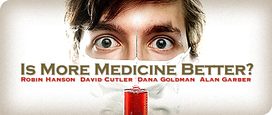Robin Hanson wants to cut the medical baby in half — an ironic twist given that he is half right.
He is certainly correct that the role of medicine has been overstated. Health care can only do so much to improve population health. Much of the dramatic mortality improvements over the last century can be attributed to changes outside of the medical system: better nutrition, improved sanitation, reduced smoking (at least over the last half century), and other public health improvements are but a few examples.
Diseases like hypertension, cancer, and diabetes explain much of a person’s longevity and quality of life, and medicine can do little to prevent them. Onset is mainly linked to genes, socioeconomic status, environment, viral exposure, and perhaps most importantly, health-related behaviors. The rest is random luck.
He is also correct that the strongest evidence comes from the RAND Health Insurance Experiment (HIE). The HIE randomized families to health insurance plans of varying generosity. One of the main findings of this experiment was that families in the least generous plan (95 percent coinsurance) spent nearly 30 percent less on medical care with little or no difference in health. Although there was not compelling evidence that higher cost-sharing led to worse health outcomes, low-income participants who were in poor health appeared to be more vulnerable to adverse outcomes. For example, poor people with high blood pressure had slightly higher mortality rates if they had higher cost-sharing. While Robin Hanson rightly questions the statistical criteria in this study, the relationship between insurance and outcomes has been corroborated in other settings — for example, when Medi-Cal suddenly and unexpectedly removed eligibility for certain hypertensive patients, and their blood pressure control worsened.
However — and where Robin Hanson goes astray — is that once someone has a disease, the health care system now offers valuable therapeutic choices. The HIE is more than three decades old, and in that time period many new therapies have emerged. Drugs in particular can be very effective when used properly. For patients with HIV, congestive heart failure, high cholesterol, diabetes, and schizophrenia, evidence is emerging that drugs are providing long-term health benefits. One study found that HIV drugs alone have generated more than one trillion dollars in value. In fact, better treatment and drugs are responsible for approximately half the decline in U.S. deaths from coronary heart disease from 1980 to 2000.
There is a lot of waste in the system, as the evidence cited by Hanson and others makes clear. But how do we eliminate it? Asking people to spend more out-of-pocket clearly isn’t enough. The HIE found that participants in the high cost-sharing group were as likely to reduce “appropriate” as “inappropriate” care, as defined by groups of medical experts. The reality is that there is enormous variability in the benefits that different patients receive from treatment, and hence much of the medical care we buy gets wasted. So, while on average, care is worth it, the marginal dollar may not buy much. There is both overtreatment and undertreatment at the same time. The lesson, then, is that we should be spending a lot less in some areas, but also spending a lot more elsewhere.
I agree with Robin Hanson’s view that the health policy debate is preoccupied with the wrong issues — for example, covering the uninsured. The real challenge for society is deciding how we can best buy better health, not just health care. In fact, I suspect that early child development, education, clean air, and medical research may offer better returns than health insurance and more medical services. But it may also turn out society should be spending more, not less, on medical care — just doing so in a more prudent manner.
—
Dana Goldman is the RAND Chair in Health Economics and the Founding Director of the Bing Center for Health Economics at RAND.

